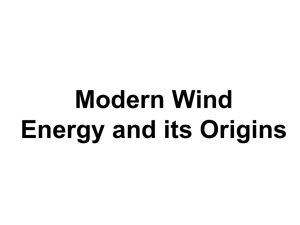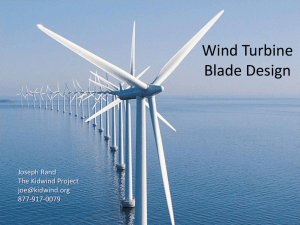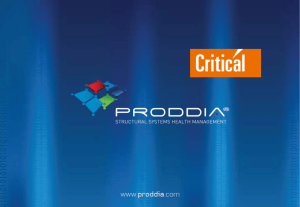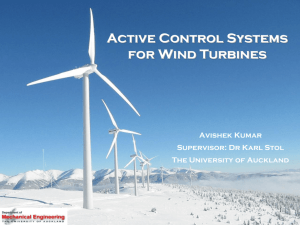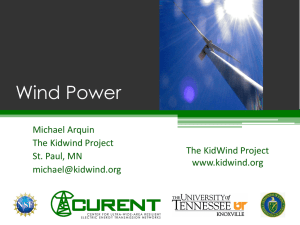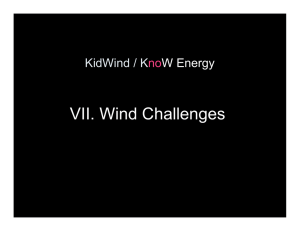File WindTurbineBladeDesign..March.08
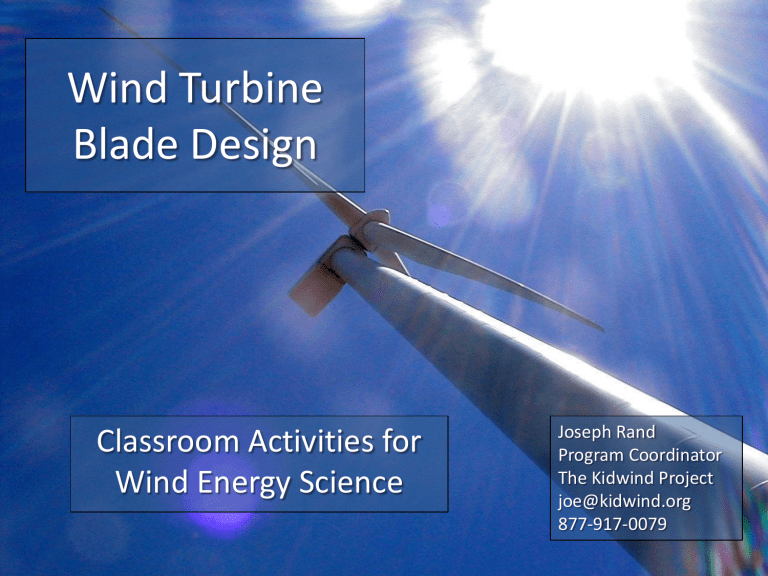
Wind Turbine
Blade Design
Classroom Activities for
Wind Energy Science
Joseph Rand
Program Coordinator
The Kidwind Project joe@kidwind.org
877-917-0079
What is KidWind?
The KidWind Project is a team of teachers, students, engineers and practitioners exploring the science behind wind energy in classrooms around the US. Our goal is to introduce as many people as possible to the elegance of wind power through hands-on science activities which are challenging, engaging and teach basic science principles.
Orientation
Turbines can be categorized into two overarching classes based on the orientation of the rotor
Vertical Axis Horizontal Axis
Calculation of Wind Power
•
Power in the wind
3
– Effect of swept area, A
– Effect of wind speed, V
– Effect of air density,
R
Swept Area: A = πR 2
Area of the circle swept by the rotor (m 2 ).
Number of Blades – One
• Rotor must move more rapidly to capture same amount of wind
– Gearbox ratio reduced
– Added weight of counterbalance negates some benefits of lighter design
– Higher speed means more noise, visual, and wildlife impacts
• Blades easier to install because entire rotor can be assembled on ground
• Captures 10% less energy than two blade design
• Ultimately provide no cost savings
Number of Blades - Two
• Advantages & disadvantages similar to one blade
• Need teetering hub and or shock absorbers because of gyroscopic imbalances
• Capture 5% less energy than three blade designs
Number of Blades - Three
• Balance of gyroscopic forces
• Slower rotation
– increases gearbox & transmission costs
– More aesthetic, less noise, fewer bird strikes
Blade Composition
Wood
Wood
– Strong, light weight, cheap, abundant, flexible
– Popular on do-it yourself turbines
• Solid plank
• Laminates
• Veneers
• Composites
Blade Composition
Metal
• Steel
– Heavy & expensive
• Aluminum
– Lighter-weight and easy to work with
– Expensive
– Subject to metal fatigue
Blade Construction
Fiberglass
• Lightweight, strong, inexpensive, good fatigue characteristics
• Variety of manufacturing processes
– Cloth over frame
– Pultrusion
– Filament winding to produce spars
• Most modern large turbines use fiberglass
Large Wind Turbines
• 450’ base to blade
• Each blade 112’
• Span greater than 747
• 163+ tons total
• Foundation 20+ feet deep
• Rated at 1.5 – 5 megawatt
• Supply at least 350 homes
Lift & Drag Forces
• The Lift Force is perpendicular to the direction of motion. We want to make this force
BIG .
α = low
α = medium
<10 degrees
• The Drag Force is parallel to the direction of motion.
We want to make this force small .
α = High
Stall!!
Airfoil Shape
Just like the wings of an airplane, wind turbine blades use the airfoil shape to create lift and maximize efficiency.
Twist & Taper
• Speed through the air of a point on the blade changes with distance from hub
• Therefore, tip speed ratio varies as well
• To optimize angle of attack all along blade, it must twist from root to tip
Fastest
Faster
Fast
Tip-Speed Ratio
Tip-speed ratio is the ratio of the speed of the rotating blade tip to the speed of the free stream wind.
There is an optimum angle of attack which creates the highest lift to drag ratio.
Because angle of attack is dependant on wind speed, there is an optimum tip-speed ratio
TSR =
ΩR
Where,
Ω
= rotational speed in radians /sec
R
= Rotor Radius
V
= Wind “Free Stream” Velocity
V
R
ΩR
Performance Over Range of Tip
Speed Ratios
• Power Coefficient Varies with Tip Speed Ratio
• Characterized by Cp vs Tip Speed Ratio Curve
0.4
Cp
0.3
0.2
0.1
0.0
0 2 4 6
Tip Speed Ratio
8 10 12
Betz Limit
All wind power cannot be captured by rotor or air would be completely still behind rotor and not allow more wind to pass through.
Theoretical limit of rotor efficiency is 59%
Most modern wind turbines are in the 35
– 45% range
Rotor Solidity
Solidity is the ratio of total rotor planform area to total swept area
Low solidity (0.10) = high speed, low torque a
R
High solidity (>0.80) = low speed, high torque
A
Solidity = 3a/A
In the Classroom…
Wind Turbine Blade Challenge
• Students perform experiments and design different wind turbine blades
• Use simple wind turbine models
• Test one variable while holding others constant
• Record performance with a multimeter or other load device
• Goals: Produce the most voltage, pump the most water, lift the most weight
– Minimize Drag
– Maximize LIFT
– Harness the POWER of the wind!
Measuring/Storing Power Output
Setting Up the Blade Challenge
What You Need:
– Box Fan (2-4 depending on class size)
– Blade Materials
• Balsa
• Paper/styrofoam plates/bowls
• Cardstock, cardboard, corrugated plastic
• Pie tins, etc.. etc.. etc… (leftover junk!)
– Scissors
– Glue/Tape
– Voltmeters, multimeters, and/or water pumps
– Hubs, motors (generators), towers, dowels
Other Challenges
For More Power…
Get Your Students to Work Together…
And make a miniature Wind Farm!
• Wire the wind turbines together in a circuit
• Series vs. Parallel
• Dramatic increase in power!
Standards
• Scientific Processes
– Collecting & Presenting Data
– Performing Experiments
– Repeating Trials
– Using Models
• Energy Transformations (forms of energy)
– Mechanical Electrical
• Circuits/Electricity/Magnetism
• Use of simple tools and equipment
• Engineering design processes
• Renewable vs. Non-Renewable resources
Math Lessons
• Tip Speed Ratio
• Calculating Height Using Similar Triangles
• Coefficient of Power
• Swept Area
• Gear Ratios
• Total Power Calculations
• Word Problems (economics, etc.)
• Etc…
The Kidwind Project www.kidwind.org
